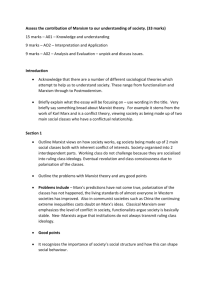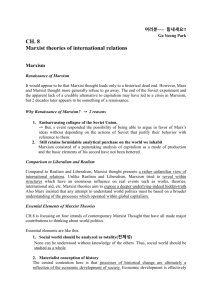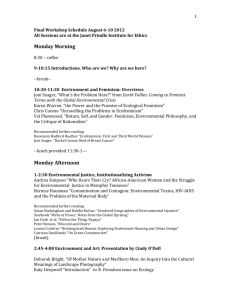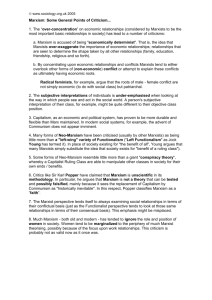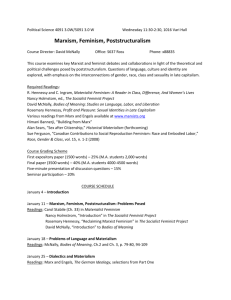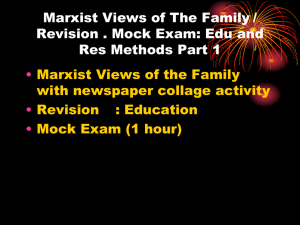PS-4091-3-second-essay
advertisement
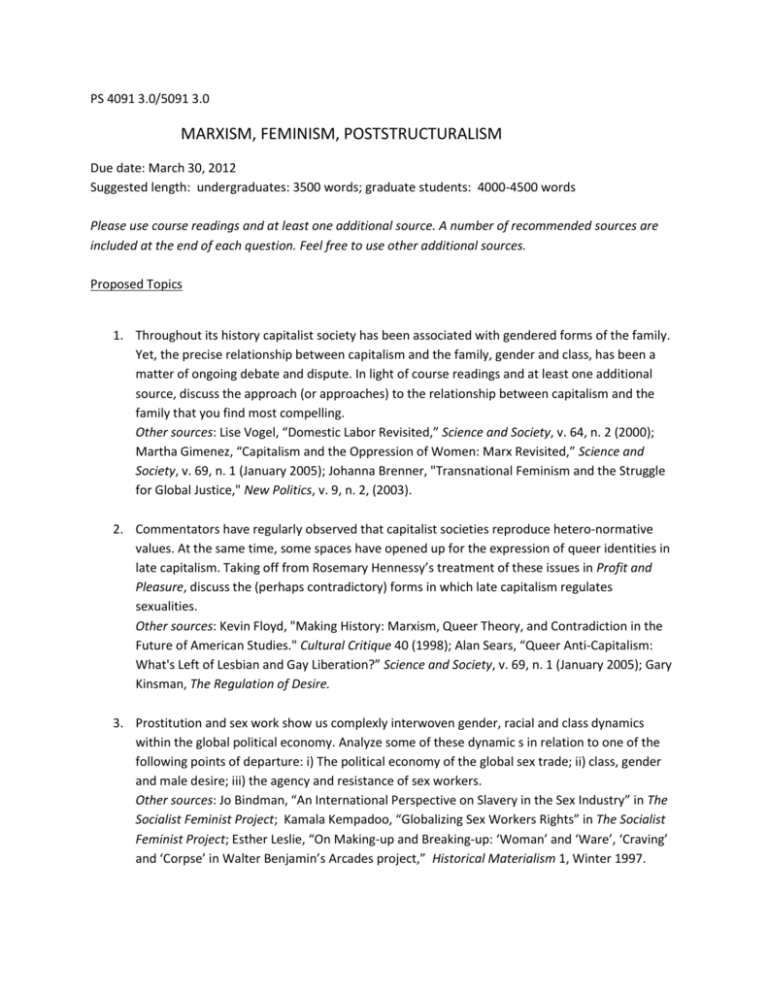
PS 4091 3.0/5091 3.0 MARXISM, FEMINISM, POSTSTRUCTURALISM Due date: March 30, 2012 Suggested length: undergraduates: 3500 words; graduate students: 4000-4500 words Please use course readings and at least one additional source. A number of recommended sources are included at the end of each question. Feel free to use other additional sources. Proposed Topics 1. Throughout its history capitalist society has been associated with gendered forms of the family. Yet, the precise relationship between capitalism and the family, gender and class, has been a matter of ongoing debate and dispute. In light of course readings and at least one additional source, discuss the approach (or approaches) to the relationship between capitalism and the family that you find most compelling. Other sources: Lise Vogel, “Domestic Labor Revisited,” Science and Society, v. 64, n. 2 (2000); Martha Gimenez, “Capitalism and the Oppression of Women: Marx Revisited,” Science and Society, v. 69, n. 1 (January 2005); Johanna Brenner, "Transnational Feminism and the Struggle for Global Justice," New Politics, v. 9, n. 2, (2003). 2. Commentators have regularly observed that capitalist societies reproduce hetero-normative values. At the same time, some spaces have opened up for the expression of queer identities in late capitalism. Taking off from Rosemary Hennessy’s treatment of these issues in Profit and Pleasure, discuss the (perhaps contradictory) forms in which late capitalism regulates sexualities. Other sources: Kevin Floyd, "Making History: Marxism, Queer Theory, and Contradiction in the Future of American Studies." Cultural Critique 40 (1998); Alan Sears, “Queer Anti-Capitalism: What's Left of Lesbian and Gay Liberation?” Science and Society, v. 69, n. 1 (January 2005); Gary Kinsman, The Regulation of Desire. 3. Prostitution and sex work show us complexly interwoven gender, racial and class dynamics within the global political economy. Analyze some of these dynamic s in relation to one of the following points of departure: i) The political economy of the global sex trade; ii) class, gender and male desire; iii) the agency and resistance of sex workers. Other sources: Jo Bindman, “An International Perspective on Slavery in the Sex Industry” in The Socialist Feminist Project; Kamala Kempadoo, “Globalizing Sex Workers Rights” in The Socialist Feminist Project; Esther Leslie, “On Making-up and Breaking-up: ‘Woman’ and ‘Ware’, ‘Craving’ and ‘Corpse’ in Walter Benjamin’s Arcades project,” Historical Materialism 1, Winter 1997. 4. Among the most prominent frameworks for analyzing the interconnections of race, class and gender are those associated with “intersectionality” and Social Reproduction Feminism. Compare and contrast these approaches. How successfully do you think they have integrated gender, race and class analysis? Other sources: Patricia Hill Collins, “Toward a New Vision: Race, Class, and Gender as Categories of Analysis and Connection,” Race, Sex & Class, v. 1, n.1; J. C. Nash, “Re-thinking Intersectionality,” Feminist Review, 89 (2008); J. Acker, “Rewriting class, race, and gender: Problems in feminist Rethinking,” in Myra Marx Ferree, Judith Lorber and Beth B. Hess (Eds.), Revisioning Gender; R. M. Brewer, “Theorizing race, class and gender: The new scholarship of Black feminist intellectuals and Black women's labour,” in S.M. James & A. P. A. Busia (Eds.), Theorizing black feminisms: The visionary pragmatism for Black women(1993); Johanna Brenner, “ Intersections, locations, and capitalist class relations: Intersectionality from a Marxist perspective,” in J. Brenner, Women and the politics of class, pp. 293-324; Isabella Bakker and Rachel Silvey, “Introduction” to Beyond States and Markets: The Challenges of Social Reproduction. 5. Marxism is generally seen as a social theory that focuses on labour as the key activity linking humans together, while poststructuralists emphasize language. However, there are a number of Marxist writers who have tried to connect labor and language together into a deeper historical materialist theory. Discuss some of these Marxist treatments of language, analyzing their strengths and/or weaknesses. Other sources: David McNally, “Language, History, and Class Struggle,” Monthly Review, v. 47, n. 3 (1995); Peter Ives, “Language, Agency and Hegemony,” Critical Review of International Social and Political Philosophy, v. 8, n. 4, December 2008; Symposium on Peter Ives's recent book, Gramsci's Politics of Language: Engaging the Bakhtin Circle and the Frankfurt School, Rethinking Marxism: A Journal of Economics, Culture & Society, v. 21, n. 3; Jean-Jacques Lecercle, A Marxist Philosophy of Language (feel free to select relevant chapters). 6. Arguably the most sophisticated historical materialist treatments of language have been associated with the “Bakhtin School” in Russia and its critique of structural linguistics. Take one text from that school (e.g. V.N. Voloshinov, Marxism and the Philosophy of Language, or Mikhail Bakhtin, Speech Genres and Other Late Essays) and assess its success at contributing to a materialist linguistics.


